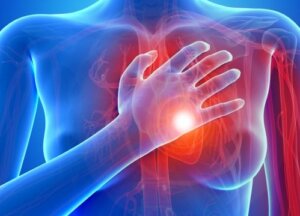The Symptoms of Heart Diseases in Women


Written and verified by psychologist Valeria Sabater
Coronary heart disease is one of the leading causes of death today. It’s important to know that heart diseases in women can occur with hardly any evident symptoms.
That’s why it is essential to know more about these ailments and learn how to notice them and identify their symptoms, no matter how small they may be. It’s worth bearing this in mind, which is why we want to show you the information clearly and simply.
We recommend that you consult a specialist if you have any symptoms of the following diseases. The indications described here do not replace the indications of a doctor.
The causes of coronary heart disease can be very different between the sexes. Women are sometimes more prone to suffer from certain diseases according to their lifestyles.
Sometimes, we may even feel nothing more than slight tiredness that assumes is because of the pressure of daily obligations… However, these are small symptoms that you should take into account, especially if you’re a woman.
Heart diseases in women and their symptoms
1. Angina pectoris
Angina pectoris occurs when the heart doesn’t receive enough oxygen-rich blood.
In men, it presents as a fairly strong pressure in the chest that can go all the way up the arm.
However, in women, it tends to be different. It tends to manifest itself as a burning, undefinable pressure, localized more in the neck, jaw, throat, abdomen, and even back. It’s also more diffused in women than in men.
- An important fact to bear in mind: When men suffer from angina pectoris, they feel more pain during physical activity, but it’s relieved when they are at rest. The opposite is true for women, who are more likely to suffer from angina while they’re sleeping.
- There’s also evidence that emotional problems, stress, and anxiety increase the risk of this type of heart disease in women.
You might like: Relieve Back Pain with a Simple Breathing Technique
2. Symptoms of a heart attack in women
The most common symptom that precedes a heart attack is chest pain. However, according to statistical data, only half of all women have discomfort, pressure, or discomfort in this part of the body.
We should therefore take the following data into account:
- Sometimes, heart disease in women is confused with other conditions. Keep an eye out for continued back or neck pain, indigestion, heartburn, nausea, nausea, extreme tiredness, and shortness of breath when climbing stairs.
- Lightheadedness and dizziness are also very characteristic signs of a heart attack in women. Men, on the other hand, often suffer from cold sweats and pain in the left arm.
3. Heart diseases in women: Heart failure
We suffer from heart failure when the heart is unable to pump enough blood for our body. As a result, it has trouble meeting the demands of everyday activities.
How does it affect women?
Pay attention to your legs, your ankles, the veins in your neck. If they’re always swollen and you feel very tired, see your doctor for a check-up.
We think you’d like to read: The Benefits of Elevating Your Legs for 20 Minutes Per Day
4. “Broken heart syndrome,” or stress cardiomyopathy
“Broken heart syndrome,” or stress cardiomyopathy, is temporary cardiomyopathy similar to an acute coronary syndrome, although reversible. It generally has a good prognosis. It affects women to a greater degree, which is why we should take it into account.

It’s one of the most recently identified heart diseases, and today it has a lot of incidences. It’s also associated with severe emotional stress: a loss, a very high daily anxiety, personal problems, etc.
This level of stress causes our heart to present a bulging of the tip of the left ventricle due to hyperstimulation. The symptoms of the so-called “broken heart syndrome” are choking and tiredness.
If you’re going through a complicated situation in your life and you feel a continuous choking sensation, go to the doctor for an examination. The mortality rate associated with this disease is low, but it still represents an alteration in the functioning of our hearts.
This disease affects mostly women. You must take this into account. To help prevent it, learn to manage your emotions, practice relaxation techniques, or do a little physical exercise to release tension. It’s essential for your health. Don’t forget it!
Main image courtesy of © wikiHow.com
All cited sources were thoroughly reviewed by our team to ensure their quality, reliability, currency, and validity. The bibliography of this article was considered reliable and of academic or scientific accuracy.
- Müller-Nordhorn, J., & Willich, S. N. (2016). Coronary Heart Disease. In International Encyclopedia of Public Health. https://doi.org/10.1016/B978-0-12-803678-5.00090-4
- World Health Organization. (2011). Cardiovascular Diseases Fact Sheet. Media. https://doi.org/Y642226357622U66 [pii]r10.3233/BME-2009-0567
- W H O. (2013). WHO Cardiovascular diseases (CVDs). https://doi.org/10.1016/j.vibspec.2013.08.005
This text is provided for informational purposes only and does not replace consultation with a professional. If in doubt, consult your specialist.








